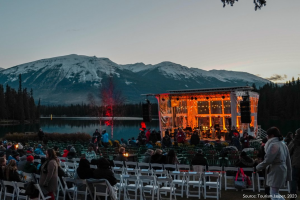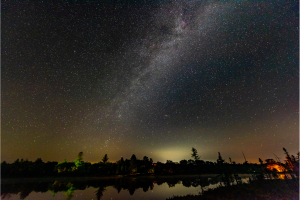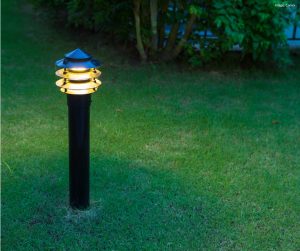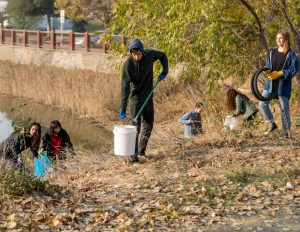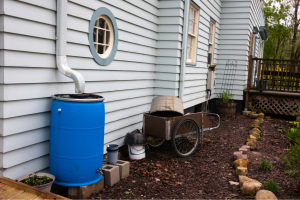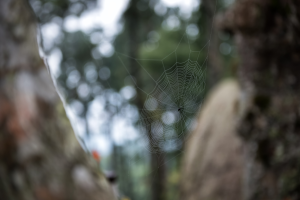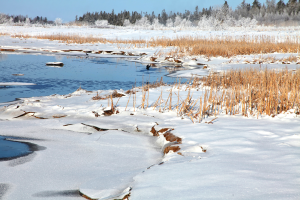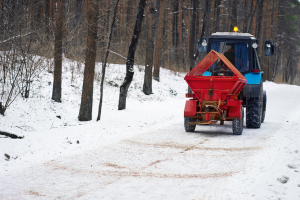by Nicole Dubé, Freshwater Health Coordinator In the urban landscape of Ottawa, Ontario, greening initiatives are taking root—one small garden at a time. Across the city, community groups joined together to embark on greening projects. From pollinator gardens to rain gardens and community plots, these projects offer many benefits to both ecosystems and the communities they serve. Learn more about these local projects and how you can start your own! Pollinator Gardens Many of Canada’s ... Read More
Worldwide Initiatives to Combat Light Pollution
by Andres Clavier, Freshwater Stewardship Education Intern Light pollution, often overlooked, is an environmental concern that affects our night skies, ecosystems, and even human health. Artificial light pollution disrupts the natural order of ecosystems, affects the behaviour of nocturnal animals, and disrupts human sleep cycles. Globally, nations are taking notice and implementing measures to combat the growing issue of over-illuminated nights. Here are some of the notable measures being ... Read More
The Importance of Dark-Sky Reserves for Wildlife and Ecosystems
by Andres Clavier, Freshwater Stewardship Education Intern Light pollution is excessive or misdirected artificial light and it is stealing our starry nights, posing substantial threats to wildlife and our own well-being. This has spurred a global push for 'Dark-Sky Reserves' — sanctuaries free from light pollution. Why are these areas crucial for both nature and people? Dark-Sky Reserves have many wildlife benefits. They act as sanctuaries for bird migration as many bird species, ... Read More
Light pollution: A Hidden Threat to Biodiversity, our Night Sky, and our Health
by Andres Clavier, Freshwater Stewardship Education Intern We live in a world constantly surrounded by artificial light, but we may not realize how much it affects us and the planet. Light pollution is a serious problem that goes beyond obscuring our view of the stars; it also has significant impacts on human and natural ecosystems. To understand the issue, we must explore the nature of light pollution, its various forms, and how it impacts our world. Light pollution is unwanted, ... Read More
How to Choose Dark-Sky-Friendly Lights
by Andres Clavier, Freshwater Stewardship Education Intern Light pollution is becoming an increasing concern for urban and waterfront dwellers, wildlife enthusiasts, astronomers, and eco-conscious individuals. While we all enjoy the conveniences of over-lit streets, properties, and cities, the unintended consequence has been a sky filled with artificial glow that disrupts wildlife and ecosystems. What if we could have illuminated properties and cities without the negative ecological effects? ... Read More
Reclaiming our Refuse: The Power of Community Shoreline Cleanups
by Ty Fischer, Riparian Health Restoration Intern In many ways, the shorelines of our lakes and rivers provide windows into the health of the freshwater systems themselves. For instance, lakes and rivers with dense vegetative buffers on their shorelines are more likely to have better water quality and healthier aquatic plant and animal communities, as opposed to those with barren shorelines that are more likely to suffer from increased toxin and nutrient input from runoff, high sediment ... Read More
Managing Water Runoff
by Samantha Cunningham, Ecological technician Landscaping your property can be as simple or as complex as you need. Landscaping is a diverse science, meaning that there are many different directions you can research, so we are going to focus on the sub-discipline of landscape engineering. For us this entails assessing what the current state of the property is and seeing where we can improve. Today’s target? Managing runoff on shoreline properties. Through this blog we will walk through ... Read More
Watersheds Canada weaves a web on World Water Day
by Monica Seidel, Communications and Fundraising Manager at Watersheds Canada Have you ever had the moment where you are out for a walk and you see the magical glint of a spider’s web? You go out of your way to avoid it, only to find yourself somehow still with a strand attaching itself to you. The spider’s web was much larger than you thought and each string was depending on the others to stay in place. A few weak links, and the spider’s web falls apart…onto your arm. Things within the ... Read More
Can Natural Buffers Help Mitigate Road Salt Pollution?
by Andres Clavier, Freshwater Stewardship Education Intern Road salts, a common winter ally for icy streets, have profound ecological impacts as the melted snow and ice wash these salts away. What role, if any, do natural buffers of vegetation along shorelines provide in protecting waterbodies against this alarming pollution? A natural buffer predominantly comprises vegetation like trees, shrubs, and grasses placed along water body edges. These buffers play a pivotal role in maintaining ... Read More
Are There Alternative Solutions to Road Salts?
by Andres Clavier, Freshwater Stewardship Education Intern In cold climates, icy roads have traditionally been navigable thanks to road salts. As environmental awareness grows, so does the quest for more ecologically kind alternatives. Although a multitude of alternatives have been tested, finding a universally accepted replacement has remained a challenge. In this blog, we will summarize some of the alternatives that are being tested and used around the world, and discuss some of their ... Read More
- « Previous Page
- 1
- 2
- 3
- 4
- 5
- 6
- …
- 17
- Next Page »


